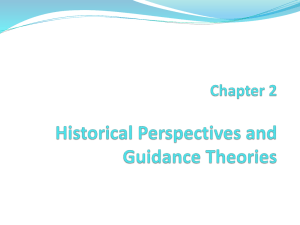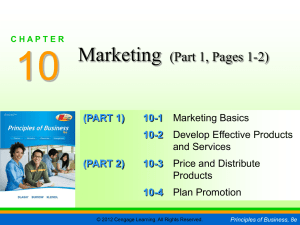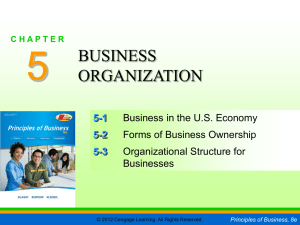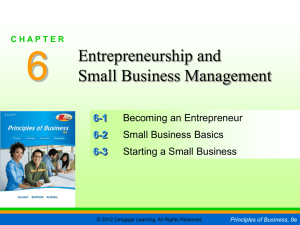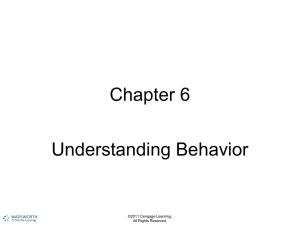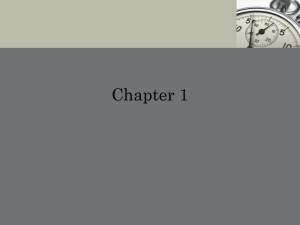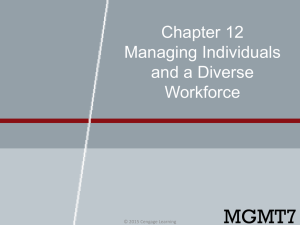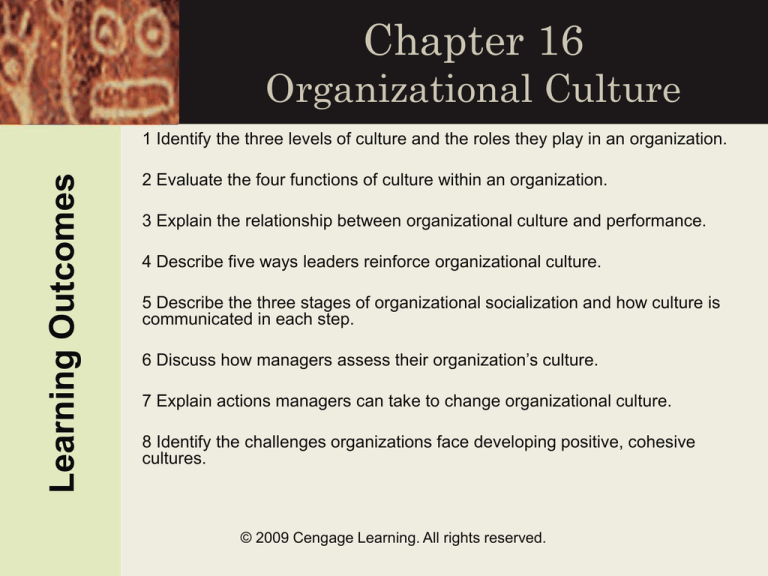
Chapter 16
Organizational Culture
Learning Outcomes
1 Identify the three levels of culture and the roles they play in an organization.
2 Evaluate the four functions of culture within an organization.
3 Explain the relationship between organizational culture and performance.
4 Describe five ways leaders reinforce organizational culture.
5 Describe the three stages of organizational socialization and how culture is
communicated in each step.
6 Discuss how managers assess their organization’s culture.
7 Explain actions managers can take to change organizational culture.
8 Identify the challenges organizations face developing positive, cohesive
cultures.
© 2009 Cengage Learning. All rights reserved.
Organizational (Corporate)
Culture
A pattern of basic assumptions that are
considered valid and that are taught to new
members as the way to perceive, think, and
feel in the organization
© 2009 Cengage Learning. All rights reserved.
1
Learning Objective
Identify the three levels of culture and
the roles they play in an organization.
© 2009 Cengage Learning. All rights reserved.
Artifacts – symbols of
culture in the physical
and social work environment
Values
Espoused: what members of
an organization say they value
Enacted: reflected in the way
individuals actually behave
Assumptions – deeply held
beliefs that guide behavior and tell
members of an organization how
to perceive and think about things
Levels of
Organizational
Culture
Artifacts
• Personal enactment
• Ceremonies and rites
• Stories
• Ritual
• Symbols
Values
• Testable in the physical
environment
• Testable only by social consensus
Basic Assumptions
• Relationship to environment
• Nature of reality, time, and space
• Nature of human nature
• Nature of human activity
• Nature of human relationships
Organizational
Culture Levels
Visible, often not
decipherable
Greater level
of awareness
Taken for granted,
Invisible, Preconscious
Reprinted with permission from Edgar H. Schein,
Organizational Culture and Leadership: A Dynamic View.
Copyright © 1985 Jossey-Bass
Inc, a subsidiary of John Wiley & Sons, Inc.
Beyond the Book:
Making Coffee, Making Coffee Matter
Caribou Coffee’s culture is based on its founders’
dreams of bringing people an inspiring and beneficial
product
Caribou’s core values encourage innovation, excellence,
and positive involvement in the world, and are reflected
in its lodge-style store designs and hourly-worker title
“vice president of smiles and service”
© 2009 Cengage Learning. All rights reserved.
2
Learning Objective
Evaluate the four functions of culture
within an organization.
© 2009 Cengage Learning. All rights reserved.
Functions of Organizational
Culture
• Culture provides a sense of identity to members
and increases their commitment to the
organization
• Culture is a sense-making device
for organization members
• Culture reinforces the values
in the organization
• Culture serves as a control
mechanism for shaping
behavior
© 2009 Cengage Learning. All rights reserved.
Beyond the Book:
Values that Benefit
New Balance Athletic Shoe empowers its US employees
to compete against low-wage suppliers overseas
The company shares competitive information with
them and offers extensive training on- and off-the-job
New Balance’s dedication to employees has a
payoff: its US workers can produce a pair of shoes
over 6 times as quickly as its overseas competitors
© 2009 Cengage Learning. All rights reserved.
3
Learning Objective
Explain the relationship between
organizational culture and performance.
© 2009 Cengage Learning. All rights reserved.
Theories about the relationship between
organizational culture and performance
Strong
Culture
Perspective
Fit
Perspective
Adaptive
Perspective
© 2009 Cengage Learning. All rights reserved.
Strong Culture
An organizational culture with a consensus
on the values that drive the company and
with an intensity that is recognizable even
to outsiders
© 2009 Cengage Learning. All rights reserved.
Strong cultures facilitate performance
BECAUSE
• They are characterized by goal
alignment
• They create a high level of motivation
because of shared values by the
members
• They provide control without the
oppressive effects of bureaucracy
© 2009 Cengage Learning. All rights reserved.
Argument that a
culture is good only
if it fits the
industry’s or the
firm’s strategy.
Fit
Perspective
Organizational characteristics that
may affect culture
Customer requirements
Competitive environment
Societal expectations
© 2009 Cengage Learning. All rights reserved.
Adaptive Culture
An organizational culture that encourages
confidence and risk taking among
employees, has leadership that produces
change, and focuses on the changing
needs of customers
© 2009 Cengage Learning. All rights reserved.
Adaptive Perspective
Adaptive
Core
Values
Most managers care
about customers,
stockholders, and
employees
Managers pay close
Common attention to all
Behavior their constituencies,
esp. customers
Nonadaptive
Most managers care
about themselves,
their work group, or
an associated product
Managers tend to
behave somewhat
insularly, politically,
and bureaucratically
Reprinted with the permission of The Free Press, a Division of Simon & Schuster, Inc. from Corporate Culture and Performance by
John P. Kotter and James L Heskett. Copyright © 1992 by Kotter Associates, Inc. and James L. Heskett.
© 2009 Cengage Learning. All rights reserved.
4
Learning Objective
Describe five ways leaders
reinforce organizational culture.
© 2009 Cengage Learning. All rights reserved.
Five Most Important Elements
in Managing Culture
5
• What leaders pay attention to
• How leaders react to crises
• How leaders behave
• How leaders allocate rewards
• How leaders hire and fire individuals
© 2009 Cengage Learning. All rights reserved.
5
Learning Objective
Describe the three stages of
organizational socialization and
how culture is communicated in
each step.
© 2009 Cengage Learning. All rights reserved.
1. Anticipatory
Socialization
Realism
2. Encounter
3. Change and
Acquisition
Outcomes of Socialization
Stages of
Socialization
From “An Ethical Weather Repart: Assessing the Organization's Ethical Climate” by John B. Cullen, et
al. In Organizational Dynamics, Autumn 1989. Copyright © 1989 American Management Association
International. Reprinted by permission of American Management Association International, New York, N.Y.
All rights reserved. Http://www.amanet. Org.
Congruence
Job demands
• Task
• Role
• Interpersonal
Mastery
Performance
Satisfaction
Mutual influence
Low levels of distress
Intent to remain
Organizational Socialization
The process by which newcomers
are transformed from outsiders to
participating, effective members of
the organization
© 2009 Cengage Learning. All rights reserved.
[Socialization Process]
1. [Anticipatory Socialization] – first
socialization stage—encompasses all of the
learning that takes place prior to the
newcomer’s first day on the job
2. [Encounter] – the second socialization stage—
the newcomer learns the tasks associated with
the job, clarifies roles, and establishes new
relationships at work
3. [Change and Acquisition] – the third
socialization stage—the newcomer begins to
master the demands of the job
© 2009 Cengage Learning. All rights reserved.
6
Learning Objective
Discuss how managers assess
their organization’s culture.
© 2009 Cengage Learning. All rights reserved.
Assessing Organizational Culture
• Organizational Culture Inventory focuses on
behaviors that help employees fit into the
organization and meet coworker expectations
• Kilman-Saxton Culture-Gap Survey focuses
on the expectations of others in the
organization
© 2009 Cengage Learning. All rights reserved.
Triangulation
the use of multiple methods to measure
organizational culture
© 2009 Cengage Learning. All rights reserved.
7
Learning Objective
Explain actions managers can
take to change organizational
culture.
© 2009 Cengage Learning. All rights reserved.
Cultural Changes
Situations That May Require Cultural Change
Merger or acquisition
Employment of people from different countries
© 2009 Cengage Learning. All rights reserved.
Reasons that Change Is
Difficult
• Assumptions are
often unconscious
• Culture is deeply
ingrained and
behavioral norms
and rewards are
well learned
© 2009 Cengage Learning. All rights reserved.
Hiring and
socializing
members who
fit in with the
new culture
4
3
Culture
Changing
behavior
Cultural
communication
Interventions for
Changing
Organizational
Culture
Removing
members who
reject the
new culture
5
1
Examining
justifications
for changed
behavior
2
Reprinted with permission from Vijay Sathe “How to Decipher & Change
Corporate Culture,” Copyright © 1985 Jossey-Bass Inc, Reprinted by permission
Of Jossey-Bass, Inc., a subsidiary of John Wiley & Sons, Inc..
Cultural Modifications in the
Current Business Environment
Support for a global
view of business
Empowerment of
employees to excel
in product and
service quality
Reinforcement of
ethical behavior
© 2009 Cengage Learning. All rights reserved.
8
Learning Objective
Identify the challenges
organizations face developing
positive, cohesive cultures.
© 2009 Cengage Learning. All rights reserved.
Support for a Global View of Business
• Create a clear
and simple
mission
statement
• Create systems
that ensure
effective
information flow
• Create “matrix
minds” among
managers
• Develop global
career paths
• Use cultural
differences as
major assets
• Implement
worldwide
management
education and
team
development
programs
© 2009 Cengage Learning. All rights reserved.
Beyond the Book:
Six Guidelines to Creating a Global Culture
1. Create a clear and simple mission statement
2. Create systems that ensure an effective flow
of information
3. Broaden managers’ minds to allow them to
think globally
4. Develop global career paths
5. Use cultural differences as a major asset
6. Implement worldwide management education
and team development programs
© 2009 Cengage Learning. All rights reserved.
REINFORCE
ETHICAL BEHAVIOR
• Clear communication of the
boundaries of ethical
conduct
• Selection of employees
who support the ethical
culture
• Reward of ethical behavior
• Conspicuous punishment of
members who engage in
unethical behavior
© 2009 Cengage Learning. All rights reserved.
Empowerment
• Empowerment unleashes
employees’ creativity
• Empowerment requires
eliminating traditional hierarchical
notions of power
– Involve employees in decision
making
– Remove obstacles to their
performance
– Communicate the value of product
and service quality
© 2009 Cengage Learning. All rights reserved.
Beyond the Book:
Six Guidelines to Creating a Global Culture
John Friel, CEO of medical device manufacturer
Medrad, Inc., is committed to continued
improvement, quality, and employee empowerment
Friel spends at least one day a month in company
shop floor operations—performing the same
customer-service and general operations tasks as
his workers
The company’s commitment to excellence earned it
the 2003 Malcolm Baldridge Award for quality in
manufacturing
© 2009 Cengage Learning. All rights reserved.

